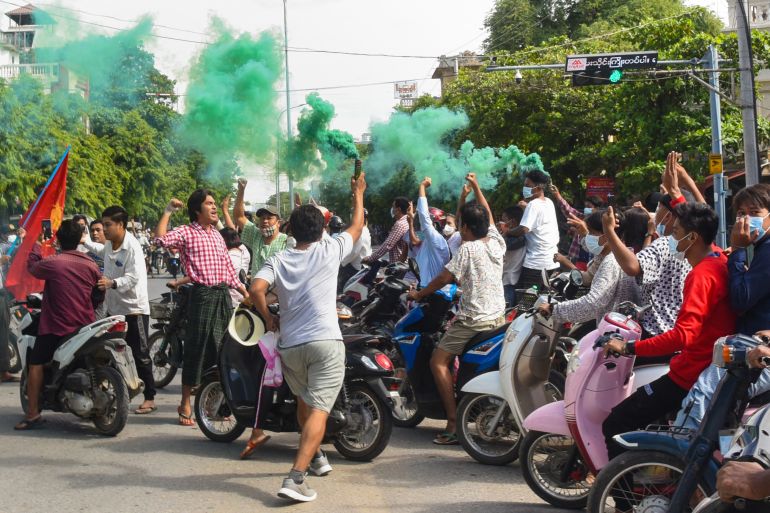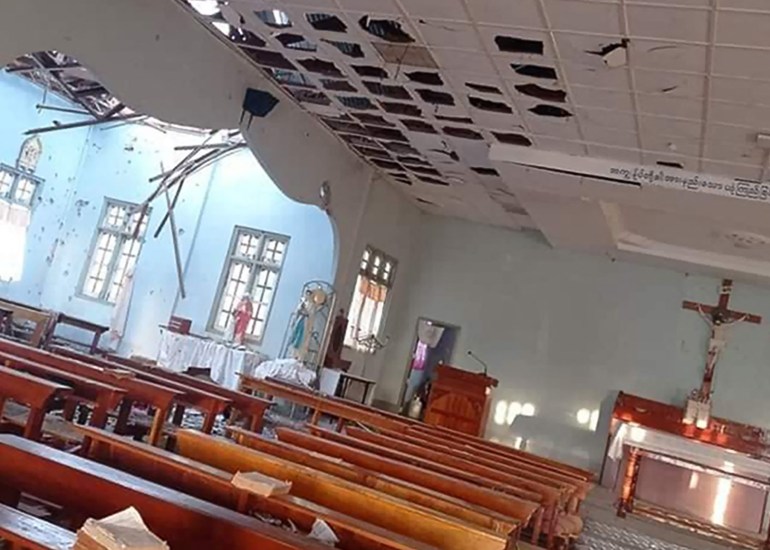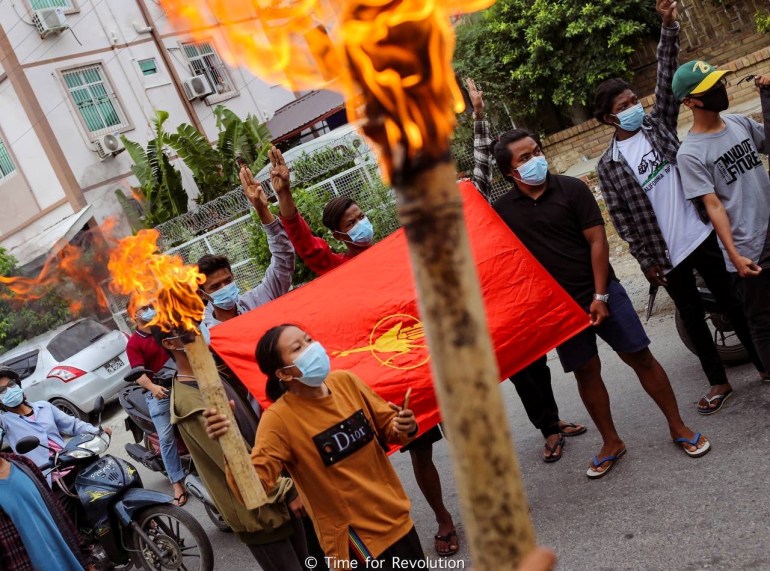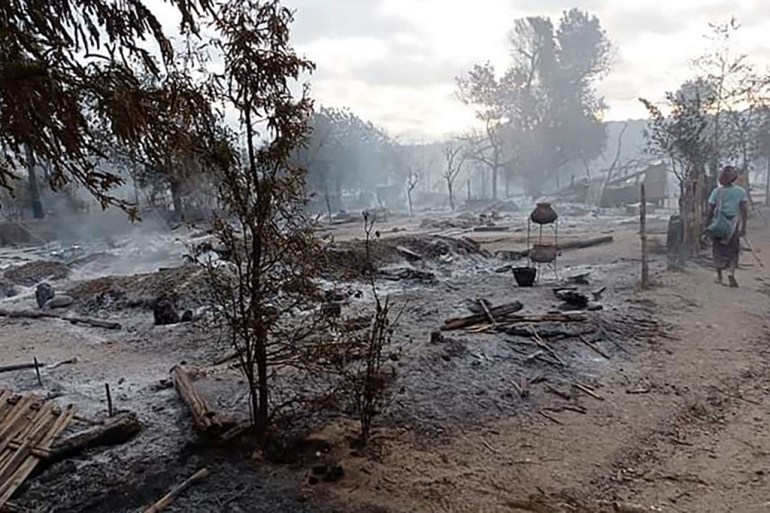Myanmar military adopts ‘four cuts’ to stamp out coup opponents
The tactic targets civilians in bid to stifle support for resistance fighters, but appears to be backfiring.

On May 24 in Myanmar’s Kachin State, 13-year-old Awng Di walked over to his aunt’s house about noontime to feed her chickens. Thirty minutes later, heavy artillery crashed through the chicken coop; Awng Di died before reaching the nearby clinic.
“Our family has never been involved in politics … We’re just trying to survive,” Awng Di’s mother told Al Jazeera. “Now, I want to curse [the military soldiers] every time I see them.”
Keep reading
list of 4 itemsMyanmar military kills at least 25 people in raid on central town
US sanctions 22, including Myanmar ministers, for military coup
UN calls on Myanmar’s military to release Aung San Suu Kyi
Momauk township, where Awng Di was from, has been the site of clashes between the Tatmadaw, Myanmar’s military, and the Kachin Independence Army, the armed wing of an ethnic armed organisation, since April. The uptick in violence in Momauk and other parts of Kachin State has displaced more than 11,000 people, according to UN estimates.
The clashes in Momauk mark a broader escalation in fighting across the country since the February 1 military coup, as decades-long conflicts between the Tatmadaw and ethnic armed organisations in Myanmar’s border areas resume or accelerate, and civilian defence forces emerge in townships that had not previously seen fighting.
In response to the increase in armed resistance, the Tatmadaw has launched indiscriminate air and ground strikes on civilian areas, displacing 230,000 people since the coup. Security forces have also looted and burned homes, blocked aid access and the transport of relief items, restricted water supplies, cut telecommunications networks, shelled places of refuge, and killed and arrested volunteers seeking to deliver humanitarian assistance.
According to Naw Htoo Htoo, programme director of the Karen Human Rights Group, the Tatmadaw’s patterns of violence since the coup mark the continuation of a strategy known as four cuts, which the military began using against Karen people in the 1960s and has since deployed against civilian populations in other ethnic minority areas.
“[The Tatmadaw] doesn’t use the words ‘four cuts’ any more, but the strategy is definitely the same as the four cuts that they used on ethnic people for over 70 years,” said Naw Htoo Htoo.
Through means including restricting access to food, funds, intelligence and recruits, the strategy seeks to starve the support base of armed resistance and turn civilians against resistance groups.
In addition to Karen State, the armed forces have also used the strategy in areas including Kachin and Rakhine states, most notoriously in northern Rakhine State in 2017 when its ‘clearance operations’ sent hundreds of thousands of mostly Muslim Rohingya fleeing across the border to Bangladesh.
According to Kim Jolliffe, an independent researcher focused on security and conflict in Myanmar, the four cuts strategy “treats civilians not just as ‘collateral damage’ but as a central resource in the battlefield.
“They are targeted directly with extreme violence and see their livelihoods intentionally destroyed so that armed groups cannot find sanctuary and civilian support,” he told Al Jazeera.
Indiscriminate violence
Since the coup, the Tatmadaw appears to have expanded its use of four cuts across the country, including in areas predominantly populated by the ethnic Bamar majority. In late March, after security forces looted homes in central Magway Region’s Gangaw township, locals began fighting back with hunting rifles. The Tatmadaw responded with heavy explosives and machine guns that killed four people and left more than 10,000 fleeing to the forest, according to local media group Myanmar Now.
Magway Region’s Pauk township also saw indiscriminate violence on the night of June 15, when more than 200 houses in Kinma village burned to the ground, killing an elderly couple trapped inside their home. Two Kinma residents who spoke to Al Jazeera on condition of anonymity said they did not know about any clashes leading up to the fire, but according to Myanmar Now, the incident occurred days after skirmishes between local resistance fighters and plainclothes police and soldiers.
One of the villagers told Al Jazeera that he saw at least nine people in plainclothes enter the village at about 11pm on June 15, setting homes on fire and shooting at the village’s cattle, pigs and buffaloes.
The Tatmadaw has blamed the incident on 40 “terrorists” and said that media who accused it of torching the village were trying to discredit it.
The military spokesperson did not answer repeated calls from Al Jazeera seeking comment on the incidents of violence or the use of the “four cuts” strategy.
Now, the residents of Kinma are scattered in nearby villages or staying in makeshift shelters in the jungle, where they are running low on food and supplies, according to Than Tun Aung, the pseudonym for one of the two villagers from Kinma interviewed by Al Jazeera. “Collecting aid is challenging because there might be police or soldiers along the way,” he said. “We are always alert and ready to run.”
‘All lives are threatened’
Kayah State and neighbouring southern Shan State, which had been peaceful before the coup, have also been the target of intense Tatmadaw attacks since May 23, when a group calling itself the Karenni People’s Defence Force overran a police station in the town of Moebye in Shan State’s Pekon township and fighting quickly spread across the region. While civilian defence fighters conducted targeted ambushes with homemade weapons, the Tatmadaw launched what the UN described as “indiscriminate attacks”, firing artillery and guns into civilian areas and displacing 100,000 people, most of whom are now living in nearby forests.
Churches, where some have sought shelter, have been repeatedly attacked, including the Sacred Heart Church in Kayah State’s Loikaw township, which was shelled on May 24, killing four people.
Aid delivery in Kayah and Shan is difficult and dangerous. The Tatmadaw has blocked the flow of goods into conflict-affected townships, killed and arrested aid volunteers, and killed two displaced people as they tried to fetch rice from their homes.

Joseph Reh, a volunteer relief worker in Pekon township who preferred his real name not be disclosed for security reasons, told Al Jazeera that his group initially used white flags when delivering aid in the hope it would protect them, but that security forces shot at them anyway.
His group stockpiled food and relief items in a school, but was initially unable to distribute the goods due to the risk of being attacked. On the afternoon of June 8, when volunteers attempted to carry sacks of rice to displaced people hiding in the mountains, he said that security forces fired at the group’s van, forcing it to turn back.
“Because of that, they found out where we keep our food and supplies,” said Joseph Reh. “They came to the school, took all our supplies to a field, and burned them” that evening. In total, he said more than 80 sacks of rice were destroyed, as well as stockpiles of other dry food items, medical supplies, an ambulance and a car.
“They destroyed things they weren’t supposed to destroy and which weren’t related to the people’s defence forces they are fighting,” said Joseph Reh. “The food supplies they burned were purely for displaced people … The ambulance they burned was not related to the fight at all. It said RESCUE and had a red cross logo.”
According to Joseph Reh, security forces fired into the mountains for the next two days, further restricting aid delivery.
In addition to shortages of food and supplies, displaced people face insufficient shelter and medical care. In Chin State’s Mindat township, where civilian defence forces took up hunting rifles and homemade weapons in mid-May, the Tatmadaw launched heavy weapon attacks which displaced more than 20,000 people. At least six displaced people have since died from lack of access to healthcare, according to Radio Free Asia.
“Everything is under military control and all lives are threatened,” said Salai Shane, the pseudonym for the head of a volunteer emergency response group in Mindat. He described “extreme difficulties” when trying to access displaced people.

On June 13, one of his group’s vehicles was seized en route from Pakokku, Magway region, to Mindat, while transporting food and raincoats; Salai Shane has since lost contact with the driver. Security forces arrested another member of the group on June 19 and confiscated his motorbike and the relief supplies which he was transporting to displaced people. During a week in custody, he was beaten and interrogated, according to Salai Shane’s account.
With aid volunteers having been shot dead in Kayah State, Salai Shane says he is especially fearful of delivering aid on foot. “Sometimes there is no route for motorbikes and we have to carry items by ourselves over several trips,” he said. “If we are in the forest or the jungle, we can be killed and our bodies disappeared.”
Military fuels anger
According to independent researcher Kim Jolliffe, the Tatmadaw is willing to do “unfathomable things” to the general public in order to retain control. “It knows only one way to deal with opposition and that is to beat every dissenting element of society into submission through extreme force,” he said.
But while the four cuts strategy may seek to turn the public against armed resistance or weaken resolve, Naw Htoo Htoo of the Karen Human Rights Group says the approach is likely to backfire.
“In the short term, there might be some impact on armed resistance due to food and water shortages and limited access to resources, but for the long term, [the Tatmadaw] will not be able to govern anywhere,” she said. “The more they oppress the people, the more civilians become stronger, because when they deliberately attack everyone, the people hate them more.”
Victims of Tatmadaw violence since the coup told Al Jazeera that the experiences have cemented their hatred of the security forces and made them even more determined to ensure their downfall.

“It will never be possible for us to view the military positively,” Than Tun Aung of Kinma village told Al Jazeera. “We just want to continue living peacefully as farmers … We have to end this military regime or we will suffer for our entire lives.”
In Mindat, Salai Shane has come to a similar conclusion. “If civilian defence forces could defeat the military and remove them from the area, we would be able to freely resume business and agricultural activities and live better lives,” he said. “We cannot separate the two: armed resistance groups are made up of civilians, because we all hate the military regime and aim to abolish it. Restricting aid to civilians will only delay the armed resistance movement, but cannot stop it.”